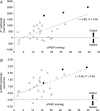High-altitude pulmonary hypertension is associated with a free radical-mediated reduction in pulmonary nitric oxide bioavailability
- PMID: 20876202
- PMCID: PMC3010150
- DOI: 10.1113/jphysiol.2010.194704
High-altitude pulmonary hypertension is associated with a free radical-mediated reduction in pulmonary nitric oxide bioavailability
Abstract
High altitude (HA)-induced pulmonary hypertension may be due to a free radical-mediated reduction in pulmonary nitric oxide (NO) bioavailability. We hypothesised that the increase in pulmonary artery systolic pressure (PASP) at HA would be associated with a net transpulmonary output of free radicals and corresponding loss of bioactive NO metabolites. Twenty-six mountaineers provided central venous and radial arterial samples at low altitude (LA) and following active ascent to 4559 m (HA). PASP was determined by Doppler echocardiography, pulmonary blood flow by inert gas re-breathing, and vasoactive exchange via the Fick principle. Acute mountain sickness (AMS) and high-altitude pulmonary oedema (HAPE) were diagnosed using clinical questionnaires and chest radiography. Electron paramagnetic resonance spectroscopy, ozone-based chemiluminescence and ELISA were employed for plasma detection of the ascorbate free radical (A(·-)), NO metabolites and 3-nitrotyrosine (3-NT). Fourteen subjects were diagnosed with AMS and three of four HAPE-susceptible subjects developed HAPE. Ascent decreased the arterio-central venous concentration difference (a-cv(D)) resulting in a net transpulmonary loss of ascorbate, α-tocopherol and bioactive NO metabolites (P < 0.05 vs. LA). This was accompanied by an increased a-cv(D) and net output of A(·-) and lipid hydroperoxides (P < 0.05 vs. sea level, SL) that correlated against the rise in PASP (r = 0.56-0.62, P < 0.05) and arterial 3-NT (r = 0.48-0.63, P < 0.05) that was more pronounced in HAPE. These findings suggest that increased PASP and vascular resistance observed at HA are associated with a free radical-mediated reduction in pulmonary NO bioavailability.
Figures


References
-
- Allemann Y, Sartori C, Lepori M, Pierre S, Melot C, Naeije R, Scherrer U, Maggiorini M. Echocardiographic and invasive measurements of pulmonary artery pressure correlate closely at high altitude. Am J Physiol Heart Circ Physiol. 2000;279:H2013–2016. - PubMed
-
- Bailey D, Ainslie P, Jackson S, Richardson R, Ghatei M. Evidence against redox regulation of energy homoeostasis in humans at high altitude. Clin Sci (Lond) 2004;107:589–600. - PubMed
-
- Bailey D, Raman S, McEneny J, Young I, Parham K, Hullin D, Davies B, McKeeman G, McCord J, Lewis M. Vitamin C prophylaxis promotes oxidative lipid damage during surgical ischemia-reperfusion. Free Radic Biol Med. 2006a;40:591–600. - PubMed
-
- Bailey DM, Davies B, Young IS. Intermittent hypoxic training: implications for lipid peroxidation induced by acute normoxic exercise in active men. Clin Sci (Lond) 2001;101:465–475. - PubMed
-
- Bailey DM, Evans KA, James PE, McEneny J, Young IS, Fall L, Gutowski M, Kewley E, McCord JM, Moller K, Ainslie PN. Altered free radical metabolism in acute mountain sickness: implications for dynamic cerebral autoregulation and blood–brain barrier function. J Physiol. 2009a;587:73–85. - PMC - PubMed
Publication types
MeSH terms
Substances
Supplementary concepts
LinkOut - more resources
Full Text Sources
Research Materials

